20. August 2018

The last years have seen radical change to the environment in which businesses have had to operate for success. The field is increasingly grasped by VUCA – volatility, uncertainty, complexity and ambiguity. Digitalization, globalization and growth of networking generate a degree of complexity that is increasing exponentially and is no longer manageable by traditional methods of leadership and cooperation. This alters the fundamental rules of creating and gathering value.
At the same time, businesses find themselves engaged in a War for Talent in light of a growing scarcity of skilled workers. Employer amenity and employee retention are ever more intensely crucial competitive advantages. Young members of the oft-cited Millenials and Generation Z have raised expectations of their employers. Against the background of an overall cultural development that increasingly emphasizes a striving for autonomy and individualism, they want their experience of life to be a lifetime of learning under ideal work conditions marked by intrinsic motivation and meaningfulness without dominance from above.
Success for a business is therefore defined by that company’s answer to the following two questions: How do we add value by distributing and efficiently tackling tasks under most complex conditions? How can the human factor be reinforced in the company and the potential of intrinsic motivation be meaningfully raised?
The role of management is central to this context. In a new form, it can provide the basis for enabling the above-named two-fold creation of value. Motivational research has identified meaning, autonomy and the sense of improvement as crucial factors of intrinsic motivation (see, for example, Dan Pink). The same factors at the same time support complexity manageability. It is therefore a pivotal component of agile management to design an environment that provides for these three factors to have a maximum impact for the people as well as the success of the company.
Purpose and framework: guides amid complexity
In the VUCA situation, clarity is eradicated by the complexity of stakeholder interests and demand, employees face a new situation every day: clear and firm goals as well as sticking to rules and processes are no longer effective. Instead of a firm distant goal that cascades ‘top down’ along a hierarchy, agile leadership raises an open field of goals that is iteratively approached and becomes more concrete with every step. Always applying the currently most attractive factors, a nearby goal is brought into focus and approached in the short term, to be reached with a precise method. Of crucial significance for the employees in this context is purpose: a clear and stable vision that provides direction and meaning without cutting available freedoms. As it adds meaning as well as value, purpose provides employees not only with a direction but also with intrinsic motivation and strong identification. Agile leadership replaces strict rules and rigid processes with frameworks and principles. Frameworks demarcate the space within which employees can autonomously create meaning and add value. Principles define a clear scope of behaviour within which it is still possible to react to individual situations.
Enabling self-organization in order to tackle complexity
Following Ashby’s Law of Requisite Variety, a more complex environment demands greater management complexity in order to be tackled. In VUCA situations, the classical hierarchical model with one top manager in charge of all decisions is prone to difficulties. The expert at the top becomes a bottleneck; the hierarchical model is too ‘plain and simple’ to match the complexity of the situation. It is therefore the central task of agile leadership to build up self-organized teams who can take decisions by themselves in autonomous processes. Self-organized teams massively increase the modality range of (temporary) leadership, cooperation and decision-finding, so that complexity is more likely to be mastered. At the same time, the autonomy entailed in self-organization is intrinsically motivating. Agile management must therefore enable and empower self-organized teams and keep them accountable.
Creating a system of continuous learning
In simple and straightforward environments, it is a proven method to first analyse a situation and then proceed to meaningful action on the basis of that evaluation. The VUCA situation undermines this process and drains its efficiency: complexity and dynamics radically shorten the lifespan of an analysis. In these kinds of situations, greater success has been achieved with a different process, namely to act first and create an empirical basis of experience, then evaluate in the short term which action was successful (and which was not) and eventually optimise the efficiency of each action and creation of value. It is a continuous learning curve, in which the experience of learning and helping others along become pivotal factors of success and essential motivators. The implementation of regular reviews (regarding the product/concept), retrospectives (regarding the type of cooperation) as well as permanent identification of impediments and clear feedback (regarding achievements and relationships) are crucial tools of agile leadership. All that cannot be achieved without establishing a learning culture in which mistakes are considered valuable opportunities for learning and put to good use. Fail fast is the central mission statement of agile management.
Cultivating Leadership
Traditional hierarchic organizations take the manager to be the driver who directly designs attainment and treats the field under their management as a machine to be perfectly configured and kept regulated, on course and well-oiled. The dominant metaphor for agile management, on the other hand, is that of a gardener who ensures that a living ecosystem continues to prosper and thrive. Agile management designs the environment, establishes the conditions, removes impediments, supports drive, fosters synergies, etc. Thereby, it acts first and foremost indirectly. It empowers and commits employees to be held accountable without abandoning them to their tasks. It makes sure that employees can adequately handle stress, conflict and tensions by themselves. It helps people help themselves. Agile leadership is therefore always also cultural and developmental work.
Agile transformation
The paragraphs above deal with the agile management of teams; the same holds true for the management of whole organizations. Instead of changing organizations towards a tightly set and long-term goal by way of hierarchically directed change management from A to B, agile leadership will keep its own company in a constant process of transformation as a learning organization guided by the leading light of a clear purpose. In the past, strategic topics were driven into the company in top-down deployment. Now, in the VUCA situation, agile leadership ideally lets them emerge out of the self-organized potential of all employees; business fields are born co-creatively, tested on a small scale, then developed step by step and, if successful, enacted in the large scale. As in traditional organizations, agile management functions as a model: if you wish to introduce agile values such as commitment, openness, focus, courage and respect into the company, you must first and foremost integrate these into your own management work and bring them to life in your own behaviour.
Johannes Ries
Photo: Hanna Göhler
Post Scriptum: This text was initially sketched out in the context of an ongoing co-creative initiative on Agile Leadership by Robert Bosch GmbH and SYNNECTA. This blog will continue to report the outcomes of this initiative. The author wishes to thank the members of the Co-Creation Team, Michael Knuth, Jörg Jockel, Dennis Heine and Martin Hurich, as well as Christian Fust for their valuable contributions.
20. October 2017
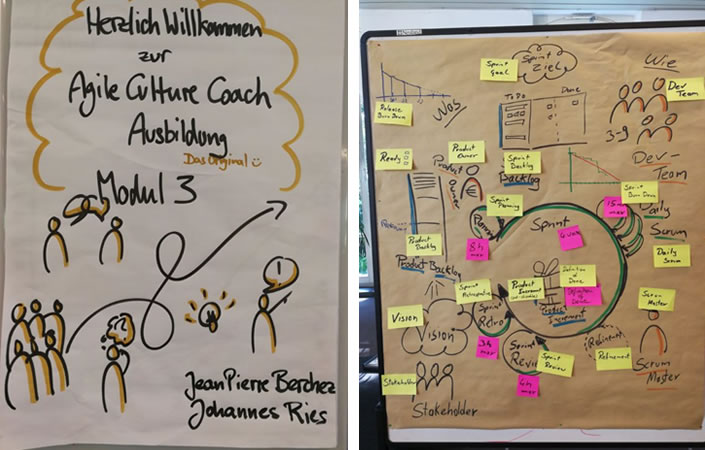
Does »Agility« and »Controlling« fit together? The big Munich »Controller Congress« had the title »Agile Controlling in the digital reality – managing upheavals successfully?«. I received a fantastic offer: Deep immersion into the subject during a professional training to the »Agile Culture Coach«. In contributions to the ICV ControllingBlog, I report about it. Today: Module 3: Agile Methods and Scrum.
The first module 1 of the training, as described here, was focused on »Agile Leadership and Participation«, Module 2 – on the »Agility and Personality« followed in May. Here »The Construct Personality« became the center of interest, and among others we discussed structural and personality tests.
In July Module 3 presented the topic »Agile Methods and Scrum«. Various agile formats, design thinking, strategy tools and conference formats were discussed. We, 14 participants, should learn the logic of agile methods and the most important tools associated with them. Objective: To be able to build Scrum teams in organizations and accompany them.
In the main topic Scrum it was at the beginning about the Scrum framework with roles, artefacts, rules etc., dealing with questions such as emergent architecture and reporting. Scrum teams and the tasks of the Scrum Masters were dealt with in detail. It was also important to pay attention to the fact that another goal of this module was to get the necessary knowledge for a successful examination to the Professional Scrum Master.
For trainers the organizer, SYNNECTA, invited two renowned experts: Jean Pierre Berchez and Johannes Ries. They led us sovereignly and captivatingly through a whole mountain of new knowledge. Berchez (picture) has been familiar with Scrum since 1995. The certified Scrum Trainer and Coach organized a.o. Scrum certification workshops with the inventors of Scrum, Dr. Jeff Sutherland and Ken Schwaber. Johannes Ries helps people in organizations find answers for business planning, strategy and organizational development in the unpredictable VUCA world.
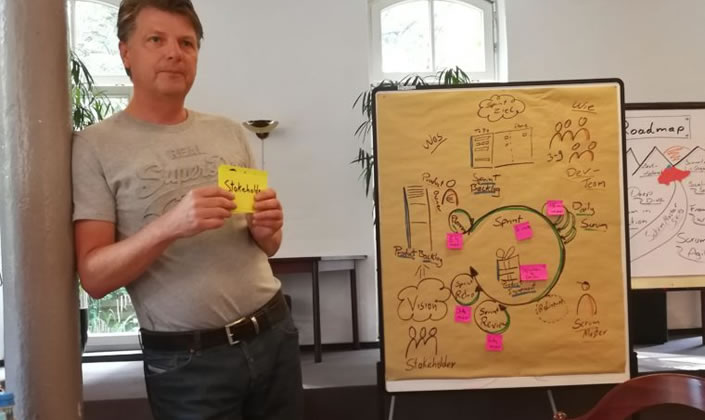
Potentials of teams
Agile teams are VUCA-resilient if they have prepared themselves for any situation by a high degree of diversity and interdisciplinarity. Teams or projects can quickly »swell« and the »task jungle« can quickly become confusing. The team members often work at different locations, possibly even in various time zones. Effective tools for task management are essential.
For »agile project management« the training module focused on Scrum – an agile method for complex development projects. Scrum is effective by combining the ability of the stakeholders to unite their potential. The Scrum concept works for various, clearly defined positions such as product owner, development team, Scrum Master. The Scrum Master, selected from the development team, supports and monitors the entire process for example. The workflows are clearly structured, in a jointly maintained task board and the completed tasks are transparent to the team. We participants learn about different Scrum tools – and try them out on our own fictitious Scrum project. For example, the »Product Backlog«, a list of user stories or requirements maintained by the product owner. There are e.g. the »sprints« – each increment is a time box of as a rule 30 calendar days – and there is the »Sprint Backlog«, a list of tasks that are required to implement the Sprint’s selected product backlog requirements in deliverable product.
Also our training module 3 was divided into (four) sprints. In Sprint 1 we built teams, where we could actively experience Scrum during these two days. In Sprint 2, as a »Scrum Team Member«, we learned to understand the »why« for agile and Scrum, so that we could later use it in our organizations (Why agility? #Cynefin #VUCA #Simulation). In Sprint 3, we learned how to use the Scrum framework effectively (and pass the certificate validation) (#Roles #Practices/Tools #Events #Artefacts #Myths). And in Sprint 4, our teams ran a Scrum practice project where we could experience Scrum in action (#Vision #Product Backlog with User Stories #Prioritizing the Backlog Items #Estimating).
Obvious, but not simple
I understand now the agile procedures and Scrum: by clear prioritizations, e.g. the products that the customer most urgently needs are made available. Deliverable (sub)products are disclosed in e.g. monthly intervals, at the end of each iteration. In the entire product development, the level reached is always transparent at all times. If something goes in the wrong direction or obstacles arise, the entire team can quickly react during the daily checks. This frequent, regular feedback in the daily rhythm ensures continuous improvements, both in the process and in the product.
The basic principles sound plausible, but Scrum is certainly not simple. Trainer and also some students with first Scrum experiences made it clear in exciting discussions that the practical implementation in complex system landscapes and organizations is anything but easy. In practice, there are no homogeneous system environments. And the biggest challenge I see in the necessary changes of the organization for a suitable framework.
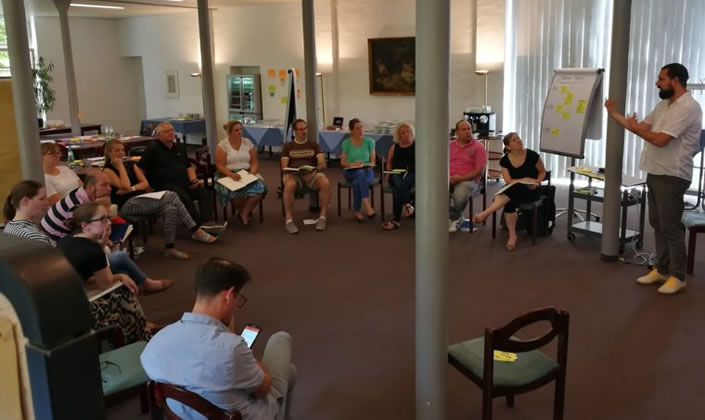
(Reports from other modules of the Agile Culture Coach training will follow.)
Hans-Peter Sander blog.icv-controlling.com
12. September 2017
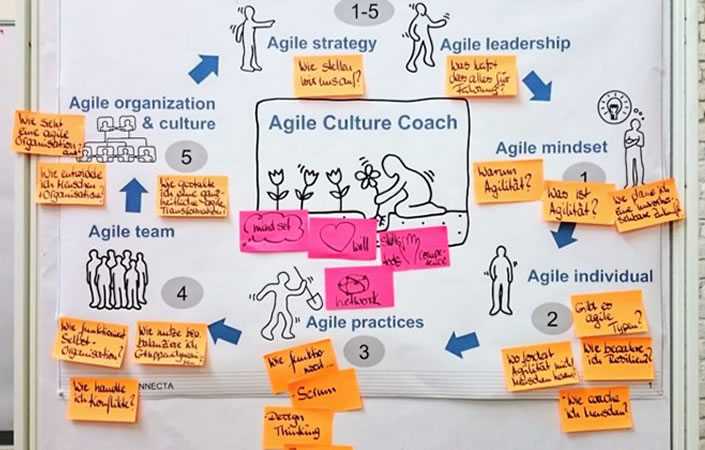
»Agility« and »management control« – that’s a match! Even this year’s large Munich »Controller Congress« agreed when they titled the event »Agile controlling in digital reality: Managing upheavals successfully«, didn’t they? Or is it not a match after all, as some critics raise in discussions time and again? I have a fantastic opportunity: I have been invited to delve deep into the topic with a professional training course to be an »Agile Culture Coach«! These blog contributions will report on my experiences.
This training course takes the form of five modules, which each last several days, over the course of a year: »Agile Leadership and Participation«, »Agility and Personality«, »Agile Methods and Scrum«, »Agile Teams and Conflicts«, »Agile Organization and Culture«. Together with 13 other participants, I am enjoying this training course by and with SYNNECTA, consultants for organizational development and change management in Cologne. It is already the third run of this course: the hosts are visibly proud to be able to name it »the original«.
»Agile Leadership and Participation«
The first three-day-module is titled »Agile Leadership and Participation«. It is a fascinating start which goes far beyond a mere introduction for guidance and terminology. We address »agile strategy« (How to we take position?), »agile leadership« (What does that mean for management?) and »agile mindset« (Why agility? What is agility? How do I plan for an unforeseeable future?)
So, what is »agility«? The views are generally hazy. Our two trainers Renate Standfest and Dr. Johannes Ries are perfectly right to mention that the word »agile« is often even used as an excuse for appointments not kept, responsibilities abused. They make a convincing case, however, that the term has its basis in »valuable thoughts and concepts« that go far beyond »showmanship and bullshit bingo«. It is these notions that give teams, organizations and management a scope for action in the current times, which our trainers describe as a »VUCA situation«.
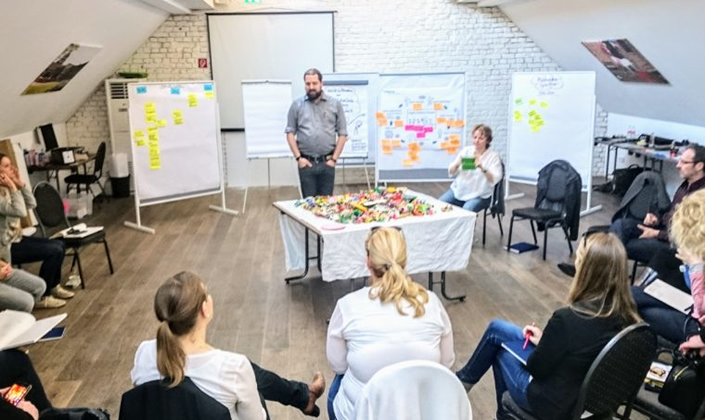
Our »current times«, dominated as they are by digitalization, political upheaval, climate change, etc. are, as is generally known, described as a »VUCA world«. VUCA comprises »volatility« (instability and fast, ground-breaking change), »uncertainty« (even incalculability), »complexity« and »ambiguity« (without simple cause-and-effect relations, ambiguity is on the fore). »Linear methods« no longer apply in this world of VUCA: so what will work?
How are we to understand »agility«? Out course instructors will not provide a »single, 100 per cent« definition. They note the »dimensions of agility« and recommend the »agile manifesto« as a basis. This »Manifesto for Agile Software Development« (it was signed by 17 persons from the field of programming in 2001) points out several key points:
- they consider »individuals and interactions« more important than processes and tools;
- they deem a »functioning product« more important than extensive documentation;
- they explicitly favour »cooperation with the client« over any (contract) negotiations;
- they expressly consider »reacting to change« more important that following a plan.
The SYNNECTA experts derive 12 principles from this manifesto: client satisfaction, openness for change, iterative development, intensive cooperation, focus on a motivating environment, face-to-face communication, functioning products as a measure of progress, steady speed, technical excellence and good design, simplicity, self-organization and self-reflection. »This list is a good summary of the mindset that is necessary for all agile practices and configurations to work«, states Ries.
Effectuation: means guidance, affordable loss and more
The course focuses on agile practices and methods that facilitate the above-named principles. »Scrum«, for example, is a term that comes from software development and by now has entered further fields. This agile method (it will be treated in depth in the third module of the course) is aimed at reducing the »scale of effort« as far as possible.
»Effectuation« is a concept that particularly catches my interest during this first module of my Agile Coach course. Once again, we are addressing hands-on consequences of the changing world, and in particular our world of work. »The dominant theme here is not ›either or‹, it’s ›as well as‹!«, explains SYNNECTA expert Renate Standfest. »With an uncertain future, where the environment can be changed and the aims negotiated, we’re on perfect ground for effectuation.« We are used to problem-solving by way of »linear causal processes«, but now is the time to recognize the circumstances, coincidences and unplanned events as opportunities and deliberately not draw a line. We are presented with a stimulating list of four principles of effectuation:
- Principle of means guidance: instead of choosing or creating the means and ways to achieve a previously defined goal, this means finding goals and results that are achievable within a given set of means.
- Principle of affordable loss: guide your investment at hand of the affordable loss, not the expected result.
- Principle of circumstances and coincidences: circumstances, coincidences and the unexpected should be used as an opportunity rather than being shut out.
- Principle of agreements and partnerships: to be made with those who are ready to take part.
Module I of my Agile Culture Coach training course is filled to the brim with a plethora of highly interesting input. I am convinced that that’s a match for the world of controlling! There is plenty of thought-provoking content on offer in these first three days alone. I had many, many new insights, from dimensions and principles of agility to effectuation, fascinating methods such as landscaping, the Stacey matrix, daily meetup, etc., and even playful elements like the team-building »marshmallow spaghetti contest« as well as the very personal presentations by the individual course participants at hand of Lego and Duplo bricks.
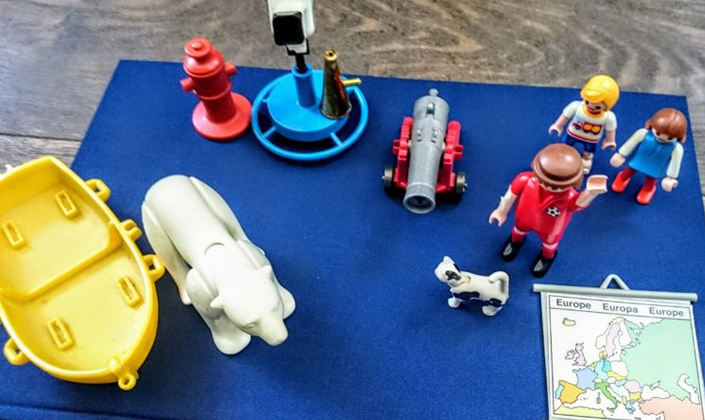
Hans-Peter Sander
blog.icv-controlling.com
1. June 2017

Looking up at a starry sky, we might have a sense of sublime peace and magnitude or hear the music of the spheres. They are ways to look or hear into the sky; images we create for ourselves. Heinrich Hertz, as a hardcore natural scientist, noted that we create images of things for ourselves that contain but an indication, in order more or less to fulfil our desire for explanations and increase or range of options. Hertz thereby dissolves the bi-fold world view that juxtaposes »The world is fact and matter« with »The world is words and stories«: every insight, every image of reality is but a potential and only valid as long as it is useful and cannot be proved wrong. They are images that describe and order our experiences with the world. They change as soon as other perspectives appear to be more effective.
In organizational development, we are currently facing such a change. All image changes have a great impact on the behaviour and actions demanded of us. How can we describe this image change?
A first, very effective, dichotomy in the description of companies began with just one word: value-adding. Over night, attitudes changed: significant functions were no longer value-adding and their value became the support of value-adding fields. It was a reassessment that at the same time opened the doors to lean thinking. Generations of managers learned that the art of management was the reduction of effort and a consistent awareness of efficiency. The daily bread of leadership were costs and their reduction, development of ever leaner processes and their reproduction. Thus emerged an ‘image’ of leadership and excellent organization, as well as an unprecedented race for the lowest cost.
We are now experiencing a new dichotomy. This one can be summed up with the terminological pair agility/excellence (the euphemism for a radical lean concept). It separates the organization into two distinctively separate enterprises, on the one side a turnout or supply chain organization and on the other side the organization dealing with innovation, product and business models. The latter is described as agile, acts in smaller units, is close to the market. This second dichotomy has been explained with the push for digitalization, a reverse push for globalization, the transition to a knowledge society. We consider it a reaction to the expectation of non-linear events, which even smart data are blind to. To put it more fashionably: disruptivity. This ever more urgent expectation that something unforeseen will happen and redefine the game is causing companies to react with their goal to themselves be the source of disruption: to be innovative, or at least highly adaptive, i.e., to be agile.
Such a goal cannot be achieved in organizations with many hierarchical levels and with the classic European-American planning and strategic logic. It requires the introduction of incremental forms of work and planning, working with vision spaces and setting goals of wastefulness as well as cost and achievement. The difference within the second dichotomy is most apparent at hand of the meaning of mistakes. In the supply organization, mistakes were and are planning and process mistakes, they are an interruption of the well-controlled and must be eradicated immediately and for good.
In agile organizations, mistakes are a ladder that can lead to the new; they are a necessary part of flexible trials, which lead to new learning. The mistake leads to further understanding. Therefore, playing becomes a leading principle for agile organizations, which can resort to notions of the Classicist period, e.g. Friedrich Schiller’s remark that a human is only human, in full possession of his and her entire potential, at play. This »other« form and logic of work applies only, however, where the event is imminent or hoped-for. The supply chain organization still maintains the reliable logic of planning, process and standardization.
As organizational developers, we tend to pounce on the new, the second side of the dichotomy, and sometimes neglect that the first side of the dichotomy, the old, is and remains the basis. The psychological reactions we experience are similar to those we saw during the first dichotomy, the differentiation between value-adding and non-value-adding: feelings of devaluation on the one side and a powerful, euphoric narcissism on the other side.
What does that mean for us? We also need to match the support we offer to this dichotomy. What are the psychological, motivational needs of the supply chain organization? It will not be possible to alter the organizational units necessary for success into a culture that corresponds to Amazon warehouses or Apple’s Foxcom organization. Even in a radical lean concept, we will have to win the heads and hearts of the people. That is all the more true as employees are required to have a decidedly higher degree of education within industry 4.0. Next to flexible education concepts, which are available in combination with blended learning approaches, we believe that we need a powerful revitalization of Kaizen: after all, the crux of these approaches is not and was never the achieved savings potential, but their motivating power by the way they foster taking responsibility. Self-efficacy has to be possible even in these highly standardized workplaces. It would be a great mistake to undervalue the human factor in the supply chain organization for the sake of efficiency.
Both attention and money are currently being primarily fed into the agile parts of the organization – method training (scrum/design thinking) is flourishing as much as the trying of new organizational forms. Manifold questions on leadership of self-organized units, etc., are addressed and offers of support are developed for teams and relatively independent units such as, e.g., the »agile coach«. We see that it can be very enriching and pleasing to work in such relatively free teams, but that it is also exhausting and sometimes threatening to be in this form of social dynamic, devoid as it is of the protective character of leadership. Amid the plethora of supervision options, it is clear that a one-off team training will not suffice. Group dynamic is dynamic and it runs an irrational course, so we consider internal and external permanent supervision. Again, blended learning can provide an additional element of support.
At the same time, an agile form of working brings up a range of organizational questions. At first, these were limited to the transition from a project team to an agile team. By now, the entire organization needs to be considered: hierarchical levels become superfluous, a whole range of questions of control and transparency remain open, hence the unrest is manifold. Responsibility and freedom of action is to be moved to the edges of the organization, so that the organization is seen in its breadth rather than in the height of the pyramid.
We are beginning to learn how such organizations work and are lead. To boot, we expect that parts of organizations are hooked up to the business although they are not classically part of it – that complicates the task of the leadership even further. Is it enough to point out charismatic leaders, who are so very much in fashion in politics at the moment? Or do we need a more in-depth re-definition of leadership behaviour, an abstract and fragmented notion of which we can find in the concepts of transformational leadership?
We take a single aspect: agility – the description of an organization that acts flexibly, fast, with many ideas and taking responsibility – is only possible when the company lives the diversity of it own employees. That means that differences are not normatively blurred, but that instead the ‘otherness’ of difference is consistently addressed. This is the only way in which it can fulfil one of the great hopes that are connected with an agile organization: that it depicts the trends, expectations and movements in society within it and aids their understanding. That is the state a company striving to be innovative and highly adaptive aims for.
What is often underestimated is the effect on the companies of what we know as governance and service units – they will have to offer platforms in future that allow a range of units with a variety of support needs to hook up. This is a place of excellence that provides its own achievements to the agile units. These units need to free themselves from the constant discussion that they are not assertive enough and grow into becoming providers of auxiliary, also flexible, solutions.
Not least, an organization that is steadily ahead of itself in order to be able to be what it will need to be can remind us of the place an »enterprise« ought to have in societies. People have questions of meaning, people want to live in a context that does not tax their conscience – we are able to engage in much self-deceit in this matter. Yet there remains a basic standard: my organization should be a good place – and in an agile world, that should be true not only within the borders of the company, but in its manifold connections with societies.
Companies will therefore hardly be able to avoid the following questions again and again: why does society tolerate our striving for profit? What is it we provide that gives us the right to egotistical striving to profit? Pharmaceutical companies putting their money into the development of medicine for children know that that is not where the big profits are, but they can chose to do so because they have a duty – free to choose, but imperative in the absolute – to be of use to the whole. Looking into the world, are not the big corporations one of the few places where global questions are negotiated? Or when did you last hear the UN mentioned on the news?
Rüdiger Müngersdorff
3. February 2017

The demands on organisations are growing steadily, while the private and business world is becoming more complex and increasingly less predictable. As the recent past has clearly shown, we are challenged daily by issues which are always good for surprises: not only digitalisation as one of the big drivers, but also other trends, such as urbanisation, progressive globalisation, environmental issues and political developments.
Many companies are rather ill-prepared for these developments and do not adequately use their own potential or the knowledge of employees who are, in fact, highly qualified. Very often, they continue with previously successful behaviour and react to new requirements with known patterns. Above all, management still largely uses methods which originated in the industrial age and are often not suited to meet the new requirements. Although the insight is fundamentally there and this is repeatedly confirmed at many of the countless conferences, in reality, little has changed so far, and if so, then rather slowly.
Why is that? Why is this existing knowledge not translated to the extent necessary? The answer is relatively simple: classical management principles have been successful in the old world for many decades. To replace or change them would mean entering upon unknown terrain and taking a risk. This leads to great uncertainty, particularly for organisations that have grown over many years. After all, there is an existing business that should not be placed in danger. Where and how do we start?
Experience shows that either detailed knowledge about the condition of one’s own organisation is very often lacking, or the assessments and pictures diverge considerably at the upper management level. Often, there is also a lack of information regarding where a successful intervention can be put in place, or there are negative experiences with change projects which are rather ineffective in the end. Management development, insofar as it exists as a solid element, often fails to achieve the desired effect, which is then a clear signal for missed or inadequate implementation measures. Causes and connections between these often observed effects are complex and mostly not obvious at first sight.
In an increasingly dynamic (VUCA-) environment, where corporate management is becoming more and more demanding, established recipes and procedures, which are often still based on stable and (therefore) more predictable times, are rather bad. Or they are completely ineffective because they provide the wrong answers to current challenges.
A typical example of this is the still-widespread instrument of management by objectives (MbO). Targets have often already been surpassed when they are agreed upon or, after a short time, they no longer fit into the changed requirements of the business. New developments that arise asynchronously, i.e. within the target period, cannot be addressed appropriately if they do not match the previously agreed targets, which often leads to a lack of resources, budget, etc. Moreover, a consistent goal development of the individual employee often leads to the self-optimisation of the individual rather than the company (division).
Effects such as these are numerous; They often establish themselves over years, creep unwittingly and unintentionally as increasingly larger disturbances against the backdrop of a changing environment and ultimately become manifested as part of an enterprise culture. Changing this is extremely difficult and ultimately only possible through a changed management.
Leaders have the responsibility of creating an environment with as few disturbances as possible so that peak performance can be achieved. The most important first step is the development of precise knowledge about the nature and effect of these »disturbances« through a complete and comprehensive analysis of the status quo. In order to make such an analysis meaningful, a comprehensive (management) model is needed which takes into account the most important aspects and their interactions within the company context.
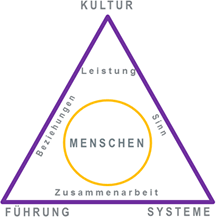 The performance triangle, developed over years by Lukas Michel and his worldwide Agility Insights-Netzwerk, is such a scientifically based model that creates a bridge between the skills of people and the challenges of organisations.
The performance triangle, developed over years by Lukas Michel and his worldwide Agility Insights-Netzwerk, is such a scientifically based model that creates a bridge between the skills of people and the challenges of organisations.
The core idea is to identify future organisational skills at an early stage so that the necessary talent, teams and structures can be developed.
People with their talents and abilities are the heart of the triangle. In the sense that »self-responsibility is an essential foundation for knowledge, work and motivation« (Peter F. Drucker) and that »trust leads« (Reinhard K. Sprenger), this promotes the speed in organisations through competent decisions on the customer front, the use of the knowledge of capable employees and management that primarily acts as an enabler.
Culture, leadership and systems form the corners of the triangle. Good decisions and effective actions require a culture that creates a common context. Management has to actively promote dialogue and interaction via purpose, orientation and performance. Systems have to work diagnostically to draw attention to what is important and to make corrections possible at any time. Intensive interactions and diagnostic control are fundamental abilities of agile organisations, since they enable early detection and interpretation of signals and corresponding actions.
Above all, in addition to knowledge, what is required for good decisions by people is purpose, which is at the same time a decisive basis for intrinsic motivation. Internal and external relationships help to continually develop and exchange this knowledge and to utilise it as added value for the customer. Combined knowledge, the collective experience and the shared benefit from it allow new developments and promote innovative power. Purpose, co-operation and relationships are the organisational skills that help to be able to absorb the shock of unexpected external shocks and influences. They are the sides that hold together the triangle of culture, leadership and systems.
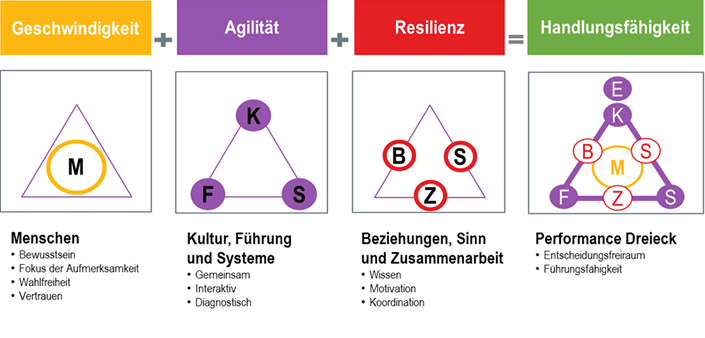
Via speed, agility and resilience, the performance triangle leads to the ability to take action. Organisations with these skills use the knowledge in the networks of employees while at the same time creating the organisational skills to deal with the dynamics of the environment as effectively as possible.
Companies with an effective management that actively shapes their own organisation for their (knowledge) employees and places people at the centre have the potential to emerge as winners of the new era.
Diagnostic mentoring is the process that allows the systematic development of these dynamic skills. It is based on 3 steps:
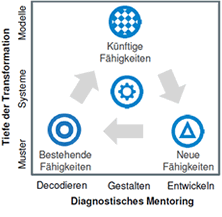
- Decoding
Analysis of the existing capabilities by comprehensive diagnostics and benchmarking (on-line tool)
- Designing
Creating the target image of the future organisational skills (CEO briefing and executive team workshops)
- Development
Creating change steps and their implementation via the performance triangle with the involvement of the operative organisation (mentoring and day workshops)
Even if there is a wealth of tools and support from specially trained mentors from the Agility Insights network, this further development for the affected companies always involves a transformation that fundamentally changes behaviour and competencies, puts existing issues into question, interferes with established processes and, therefore, always involves risks.
A fundamental development affects decision-making competences. Within the scope of further development, managers have to decide
- How they want to involve or incorporate employees
- How work is to be coordinated and guided
- How goals are set and pursued
- How changes/adaptations are made
- How decisions are made
For each of these 5 key questions, it is necessary to select and establish either
a) more self-responsibility on the part of employees or
b) control by the executive management.
Depending on the combination of the answers, different concepts for the management and the organisation arise.
This »work on the system«, the correct design of leadership and organisation, is not a task for the workforce or the lower and middle management. It cannot be delegated, but rather has to begin at the top of an organisation in the executive team.
In the beginning, a clean diagnosis, analysis and interpretation of the results as well as consensus responses to the five principle questions mentioned above are performed. Only then does the concretisation in the different functional areas of the organisation and the formulation of precise interventions begin.
It is and remains the responsibility of the executive management to decide how to address the necessary changes in order to activate the potential and implement it for the benefit of the organisation, the customers and the business.
Rüdiger Schönbohm
TYSCON Management Consulting & Business Partner Agility Insights
Pictures and individual text passages
© Agility Insights AG, 2016 / Cover picture: Pixabay










 The performance triangle, developed over years by Lukas Michel and his worldwide
The performance triangle, developed over years by Lukas Michel and his worldwide 
